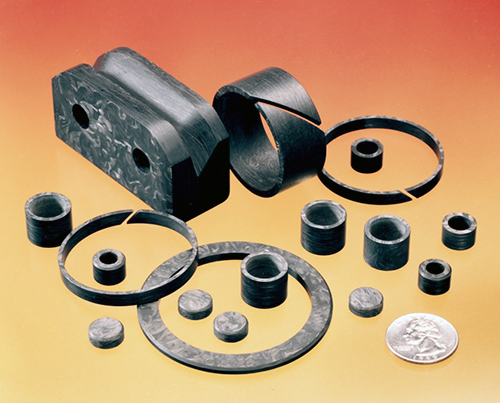Carbon Fiber Composites
HyComp®, Inc. of Cleveland, Ohio has recast Lewis Research Center development of PMR-15 polyimide resin into a line of high temperature carbon fiber composite products to solve wear problems in the harsh environment of steel and aluminum mills.
Early NASA work on advanced materials included the need for processable, high-temperature-resistant matrix resins. A polyimide resin proved well-suited for fiber-reinforced advanced composite aircraft engine components, giving these engine parts higher strength and longer wear life.
HyComp was founded on shifting NASA's PMR-15 polyimide resin technology from aerospace and military requirement to the commercial world. The result was WearComp®, self-lubricating composite wear liners and bushings.
A durable and rugged material, WearComp combines carbon graphite fibers with a polyimide binder. The binder, in conjunction with the fibers, provides the slippery surface, one that demands no lubrication, yet wears at a very slow rate. Strength, stiffness, and structural integrity are drawn from WearComp's graphite fibers.
WearComp typically lasts six to ten times longer than aluminum bronze, a time-honored material widely used in mill operations. Unlike bronze, which can gall the mating steel surface, WearComp polishes the same surface and imparts a self-lube film for years of service. It is designed for continuous operation at temperatures of 550 degrees Fahrenheit and can operate under high compressive loads.
HyComp's WearComp self-lubricating bearings negates a mill manager's most aggravating maintenance problems--grease. Grease is expensive to buy and apply, and costlier still to collect and dispose of. Whereas grease on hot mill applications can char and seize moving bearing surfaces, use of WearComp can reduce that problem dramatically. Without grease or sticking problems, worker hours are reduced, downtime of machinery is lessened, and there is a reduction in materials destined for the scrap heap.
A wide variety of chemical agents, including acids, hydraulic fluids, oils and grease, leaves WearComp virtually unscathed. Impact tests have shown the material to be far more damage tolerant than its aluminum bronze counterpart.
WearComp materials help solve downtime problems on flash trimmers for automatic butt welders on continuous steel processing lines. Composite liners made of the material wear so slowly, operators report getting a year or more of service. In comparison, aluminum bronze liners are typically replaced every 13 to 16 weeks. Similarly, guides and rails last five times longer after switching to WearComp liners.
Using computer assisted design techniques, WearComp materials can be formed to specific, dimensionally accurate wear liners for wedges, pockets, and other unique shapes. Rubbing blocks, valve seats, wheels, pulleys, wear shoes and insulators are among the items produced using WearComp.
Because of the material's uncommon properties, bearings made of WearComp can help relieve mill maintenance headaches. Use of the composite material is gaining acceptance among a growing number of mill operators and maintenance personnel.
WearComp materials add months to the life of equipment, making possible major turnarounds in maintenance programs. These long-life, self-lubricating bearing materials are now being used throughout the basic metal industries, from bar and slab casting, through the hot rolling mills.
Nearly all of the aluminum strip processing in the United States and Canada and most steel hot rolling mills and finishing lines are now utilizing these composite materials.
® HyComp and WearComp are registered trademarks of HyComp, Inc.

NASA materials research made possible a new class of self-lubricating, high-temperature carbon fiber composites now widely used in aluminum hot mills and steel rolling mills.













